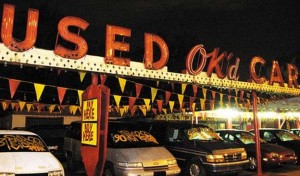Young Americans continue to put off learning to drive and then buying a car, according to a raft of recent surveys, though some of the research indicates Millennials are simply delaying, rather than abandoning, the traditionally American goal of getting wheels.
Once they do, they seem to be opting for practicality, according to one of those new studies, research by marketing platform Crowdtap suggesting that budget-minded Millennials are putting a low priority on luxury and status vehicles.
Not surprisingly, the Crowdtap study also finds that these Gen-Y buyers are more likely than American auto buyers, on the whole, to purchase previously-owned vehicles, rather than new. About 86% of those included in the survey went for something used.
(What new models top the list, according to the annual Car Book? Click Here to find out.)
Most research suggests that, on the whole, somewhere between two to three times as many used vehicles are sold in the U.S. each year compared to new – a soft number reflecting the fact that many of those are swapped between family members are sold to friends. But the Millennial numbers run significantly higher than the American average.
That would suggest several possible conclusions, according to researchers. For one thing, Millennials are typically more constrained when it comes to discretionary income, many from that generation just starting careers after struggling during the post-recession period.
There are also a lot more options for those seeking something used, including the wide availability of so-called Certified Pre-Owned, or CPO, programs now offered by virtually every manufacturer from humble Kia to exotic marques like Mercedes-Benz.
There also appear to be psychographic changes at work, according to Crowdtap’s “Millennials Behind the Wheel” study and other recent research. A summary concludes, “practicality (is) the catalyst for millennial vehicle purchasing decisions and driving behavior. Whether renting or buying, millennials are seeking a practical choice for either their short or long-term investments.”
Among those Millennials who reported buying a used vehicle, about two-thirds, or 65.9%, spent less than $25,000.
Another factor to consider, according to the study, “Trust is becoming an increasingly critical aspect when investing in a car. Brands and marketers can build trust throughout the car-buying journey by leveraging authentic peer-to-peer ratings & reviews,” said Peter Storck, SVP of research and analytics at Crowdtap.
Borrowing a slogan from the Reagan era, call it trust but verify. While Millennials appear to be even more focused on using online research to shape their buying decisions, nearly six in 10 still hold their final choice until they go for a test drive. And then, the majority want someone with more knowledge and experience to come along for the ride.
(More and more American car buyers are turning to leasing, Click Here to learn why.)
The Crowdtap study finds some notable differences in how Millennials use their vehicles, depending upon whether they live in urban or suburban environments. City dwellers are far less likely to drive to work, as might be expected, more often climbing behind the wheel to go shopping or head out on a weekend escape.
The study also shows that Millennials are particularly interested in buying environmentally friendly vehicles. But, with limited budgets, battery-electric models are priced out of reach for many. That could change in the years ahead as more mainstream options offering long range at a lower price – such as the Chevrolet Bolt EV and Tesla Model 3 – come to market.
Researchers are anticipating even more changes going forward as the next generation of potential drivers comes of age. One question that is being eagerly asked is whether the growing availability of car-sharing – along with autonomous vehicles – will lead to fewer active drivers and lower car sales.
A separate California study released this month shows that trend may already be in motion by the first cohorts of Generation-Z. The Sacramento Bee reports that only 40.5% of those teens eligible to drive in the Golden State were licensed by the end of 2015. That’s down from 44.3% as recently as 2000. Meanwhile, the total number of teens licensed by the end of ’15 was only 862,593, lower than at any point since 1997 – despite California’s growing population.
(After a big surge, gas prices suddenly fall back. Click Here to find out why and what’s coming at the pump.)


